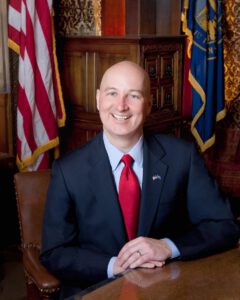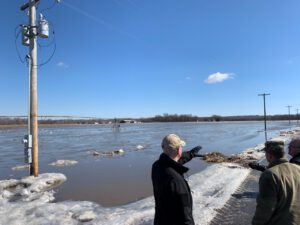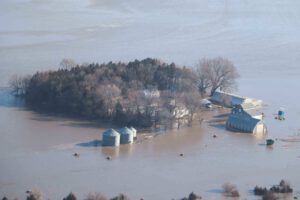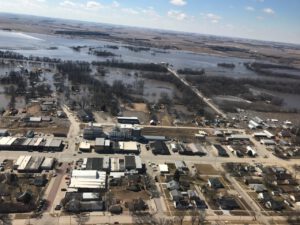T
he heavy rainfall and snowmelt that hit Nebraska in March caused the worst flooding in Nebraska’s history. All of the state’s major rivers—the Missouri, the Platte, the Elkhorn, the Loup, and the Niobrara—reached record heights, flooding homes and farmland. Dams, levees, and bridges were destroyed; livestock were washed away. Thousands of Nebraskans had to be evacuated. Governor Pete Ricketts declared that the floods had caused “the most extensive damage our state has ever experienced.”
Governor Ricketts joins Municipal Water Leader Editor-in- Chief Kris Polly this month to discuss the flood’s effects and how the state is responding to the damage and leading the recovery.

Kris Polly: Governor, please tell us about the effect of the floods on Nebraska’s infrastructure and how the recovery is going.
Pete Ricketts: The flooding has been the most widespread disaster in our state history. Thousands of people have been displaced, whole towns have been evacuated, and some towns have been entirely cut off. Some people whose homes were damaged still have not been able to move back in. At one point during the peak of the flood, a third of our 10,000 miles of state highways were closed. Within about a week, that number had dropped to about 275 miles. Eleven miles of road are still closed. Fifteen bridges were out; 12 are still out, and 27 are in need of repair. Two hundred miles of paving needs to be repaired. The flood also wiped out dams and dikes. We don’t yet have a complete list of all the damage to county roads; they are still being assessed.
It is going to take a while for us to recover from this, since this infrastructure can’t be quickly fixed. For example, we hope to have temporary structures up by August to replace two bridges on Highway 12 and Highway 281. But it will take until sometime next year before we actually have permanent solutions in place.
In total, we have about $160 million worth of needed repairs for our highway system and local roads just along federal aid routes. We estimate that we also have about $85 million in damages to homes and businesses, about $400 million in livestock losses, and about $440 million in crop losses. The effect on our state has been significant.
I can tell you that the people of Nebraska are resilient. We’ve had great response from our local emergency medical technicians, firefighters, fire chiefs, sheriffs, police chiefs, and volunteers. They have done a wonderful job of keeping Nebraskans safe. I’m confident that we will rebuild bigger, better, and stronger than ever before.
Kris Polly: Please tell us about how the natural resources districts (NRDs) across Nebraska are responding to the flooding.
Pete Ricketts: The NRDs were on the front lines during this flood event and will continue to be on the front lines with regard to recovery. During the height of the flooding, NRD staff and board members were actively assisting state, local, and federal partners with getting warnings out, assessing evacuation needs, and other public safety measures. The NRDs maintain more than 700 flood control structures, and during the flood event, the NRDs worked around the clock to monitor them, clear debris, sandbag, and implement measures to maintain their integrity. Many of those structures held despite historic amounts of water. We witnessed records on the Elkhorn River, the Loup, the Missouri, the Niobrara, and the Platte. All these river systems were inundated with water at a level we’ve never seen before. The NRDs’ flood-control structures in many cases performed admirably to protect our cities, though in some cases, it was just not enough to protect all the property during this flood. We’re grateful for all the work the NRDs have done on flood control.

As the floodwaters have receded, the NRDs continue to work with our citizens, law enforcement, and emergency personnel to assess the damage on their flood-control structures and take an inventory of projects that have been damaged.
The damage is extensive, and the situation is a lot worse than it was after the 2011 floods. Just to give you an example, with regard to Missouri River, the U.S. Army Corps of Engineers told us that in the 2011 flood, 5 levees were damaged; this time, 50 were.
That means that the recovery is going to be long and expensive. Our NRDs have done great work with local partners and with state and federal agencies to access emergency funds and to expedite emergency repairs on critical structures. Some damaged levees, for example, have already had temporary repair work done to help protect communities. Now the NRDs are working to identify high-water marks and document the effect of the flood to inform future flood-control measures. The NRDs also have a hazard mitigation plan in place to assist individual communities applying for federal funding to mitigate future flood risk.
I really can’t say enough about how great a job NRD employees and board members have done helping individuals respond to and recover from this flood and helping us access federal disaster programs and document the damage.
Kris Polly: How have the floods affected drinking water supplies in the state?
Pete Ricketts: The widespread flooding has affected a lot of public drinking water systems. Private wells were flooded, water mains were broken, and electrical systems went offline. That led to various communities losing water completely for a period of time or having their systems affected so that they were below capacity. In Boyd County, the water line was completely severed. They’re working to repair it, but it’s going to take some time, so they’ve tapped into private wells. Boyd County Rural Water System remains under a boil-water advisory. The city of Peru’s well and water treatment plant were flooded, so the city transported water from a nearby community to fill its water tower. The water system in Lincoln, our second- largest city, had its electricity knocked out for several days, reducing its water capacity. Plattsmouth’s water facilities flooded. As a backup, it has tapped into a local water system, but it is not back at full capacity yet.
Private well owners have also been affected. Nebraska’s Department of Health and Human Services (DHHS) and Department of Environmental Quality have worked with federal, state, and local partners to test private wells. We’ve tested some 786 wells and found that about 30 percent of those were positive for bacteria. We’re giving advice to those well owners about how to treat their wells so that they can provide safe drinking water to their families.
Kris Polly: What should residents do if they believe that their water supplies are unsafe or contaminated?

Pete Ricketts: If water from a private well is cloudy or its taste or smell has changed, it may be contaminated. But private well owners should test the well water if they have any indication that their water supply has been breached by floodwaters, even if there is no notable change in taste or smell. Well owners can contact a local water professional to shock-treat their wells if they have been affected by floodwater. Guidance from the University of Nebraska–Lincoln on shock chlorination can be found at flood.unl.edu. Residents with private wells can obtain test kits by calling our state lab at (402) 471-3935 or by visiting our website at nebraska.gov and searching for DHHS water testing. The water testing kit, analysis, and shipping and handling cost about $17 plus postage.
Kris Polly: What financing tools can Nebraska’s government and legislature give to NRDs or local entities to construct flood-control infrastructure for the future?
Pete Ricketts: We have a couple of programs. The state allocates $11 million every year to our Water Sustainability Fund. The NRDs, as well as other public and private entities, can apply for money from that fund to build water- sustainability and flood-control projects. The state also puts about $3.3 million a year into our Water Resources Cash Fund. We also have the Nebraska Environmental Trust, which supplies money to NRDs for flood-control measures.
There are also a couple of additional things that we can do by working with other agencies. I think we all agree that the Army Corps needs to improve its 404 permitting process. The State of Nebraska allocated $13 million in 2016 to the Papio-Missouri NRD to improve the levees around Offutt Air Force Base. The permitting process has taken 6 years and $6 million. They were finally set to start working on it this spring. If we had gotten that process done faster, the NRD would have been able to bring those levees up, which would have protected Offutt Air Force Base. The base suffered $350 million in damages.That’s an opportunity for improvement in the future. We can work with the NRDs to try to get the Army Corps to reexamine and streamline its permitting process. We have successfully shortened permitting times on the state level already, so I’m confident that the Army Corps can do it as well.
One of the other things we can do is work jointly with Congress to get the disaster bill passed. This is something that Congress really needs to focus on and get done, but it has been stalled so far. It’s important not only for Nebraska but for other states as well. I know that the Army Corps is working on a ton of different projects along the Missouri River. Fifty or more levees have been damaged in one way or another. Some of the damage is huge. One levee has a breach that is 400 yards wide and 70 feet deep. That is a major repair project. Congress can act to help us get these levees back in shape to help protect these communities from further flooding.
Kris Polly: What else can Congress and the administration do to help Nebraska at the state and local level?
Pete Ricketts: The response so far has been fantastic. We were able to get a disaster declaration in record time. The administration turned it around in just 2 days. I want to credit the Federal Emergency Management Agency (FEMA) for working with the Nebraska Emergency Management Agency to get that disaster declaration in shape so that we could submit it and for expediting its processing and getting it to the White House for President Trump to sign. Now we’ve got over 500 FEMA people on the ground. The expedited process allowed Nebraskans to tap into those federal resources quickly. So far, FEMA has distributed over $21 million in personal or individual assistance, and $22.6 million in flood insurance has been paid out. We’ve had $25.8 million in U.S. Small Business Administration loans going out to homeowners, renters, or small businesses. The U.S. Department of Transportation has given us $25 million in Quick Start funds, which we intend to use to help counties with cash flow for their repairs. Counties have to do the repair work first and can only apply for compensation afterward. Some counties may not be able to do that—the repairs they need may cost more than their roads budget. We’re going to be working quickly to get those repairs done and to get them back to normal. So far, the federal government’s response through the different agencies has been outstanding.
Kris Polly: What is your message to farmers in Nebraska who’ve been affected by the flooding?
Pete Ricketts: With regard to U.S. Department of Agriculture programs, the first thing they should do is contact the Farm Service Agency office so that they can get reimbursed through some of the programs that are out there. We have used the Livestock Indemnity Program, which reimburses livestock producers for 75 percent of the market value of the animals they’ve lost. It’s key that they document that damage. There’s also the Emergency Livestock Assistance Program for some of our nontraditional livestock, and the Emergency Conservation Program, which helps remediate pastures and cropland. I’ve seen some of the places affected, and the amount of sand and silt that has been deposited is just incredible—in some spots it is 4–5 feet deep. Some of these fields look like they’re in the desert. It is stunning to see the damage these floods have left behind. Huge blocks of ice have been left in the pastures near the Niobrara River. This is another case in which Congress could pass a disaster relief bill, it could provide relief to our farmers and ranchers, specifically with things like crop losses that are not covered by insurance.
Kris Polly: How have Nebraska’s citizens responded to the flood?

Pete Ricketts: Local folks did a fantastic job responding to the most widespread national disaster we’ve ever had in our state’s history. They did a great job keeping people safe. The victims themselves have displayed such resilience in bouncing back from this and moving on to rebuild. It has been amazing. For example, we had first responders whose houses were flooded out, and they didn’t go home. They stayed on the job, keeping people safe. There were flood victims who went to the shelter and then volunteered there. They got into the volunteer line instead of the assistance line. That’s the spirit of Nebraska. “We can’t get home, so we might as well help somebody else.” It gives meaning to the words “Nebraska Strong.” It’s been amazing to see how people responded to this tragedy.
Citizens have generously donated to organizations like the American Red Cross, Habitat for Humanity, the Nebraska Cattlemen, the Nebraska Farm Bureau, and the Salvation Army. Hay has come in from all across the Midwest, and even from as far away as North Carolina, to help our livestock producers.
Kris Polly: Please tell us about your vision for the future.
Pete Ricketts: We want to rebuild bigger, better, and stronger than ever before. It’s going to be a team effort. It’s going to require people at the local level to help assess what local needs are; it’s going to require the state to act as the quarterback; and it’s going to require federal resources as well. This is not going to be a quick recovery in some cases. Some of this infrastructure is going to take a while to rebuild. Remediating some of these fields is going to take a while as well. Some fields are likely not to get planted this spring; some pastures may not be able to be grazed.
Working together, we will continue to take the steps necessary to repair our infrastructure, remediate our farm fields and our pastures, and get back to where we were before and rebuild bigger, better, and stronger than before.
Pete Ricketts is the governor of Nebraska. He can be reached at pete.ricketts@nebraska.gov or at
(402) 471-2244.
